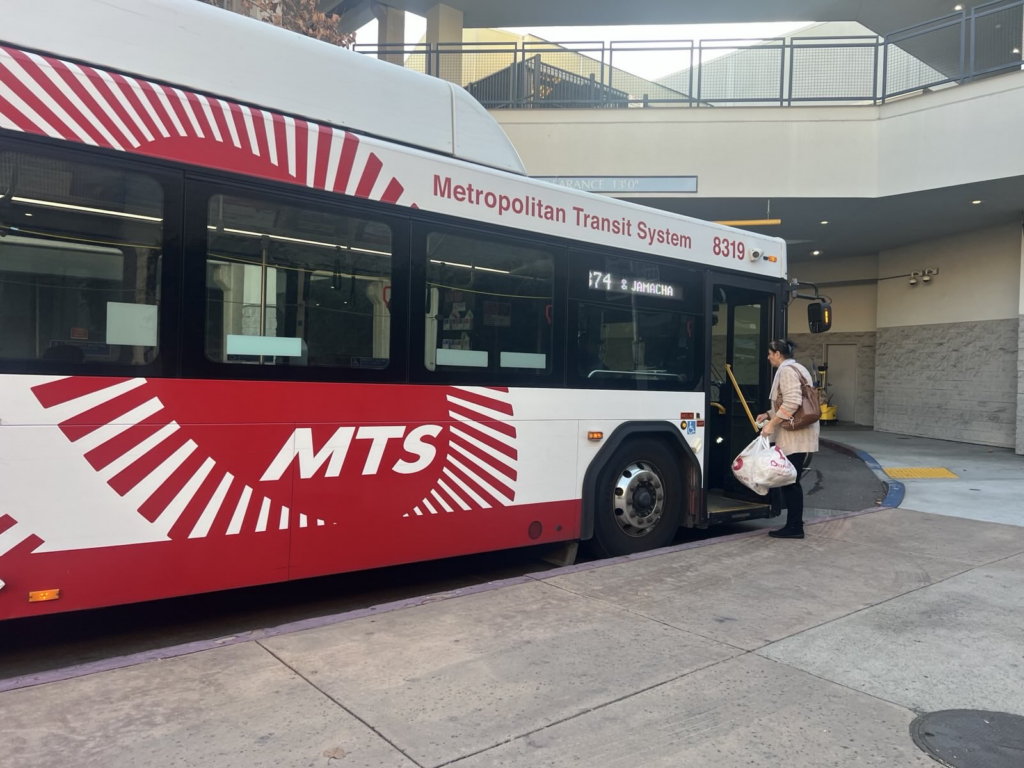
Joe Kirby, a double amputee from Boulevard, CA, is the copilot of MTS (Metropolitan Transit System) bus Route 888.
At 3:50 p.m. on Friday, Jan. 31, Kirby sat on a bench at one end of the El Cajon Parkway Plaza turnout, walking sticks perched beneath his chin. At the other end of the turnout, past the food court, driver Daniel Roman idled bus 3507.
Kirby’s day was over, more or less. He had accomplished what he’d set out to do. Earlier that morning, after waking up at home in Boulevard, he’d grabbed his backpack and walking sticks and caught the Route 888 bus around 9:50. His bus stop, if one could even call it that, existed at an indeterminable point along a stretch of roadside gravel. No sign or bench marked its existence; its only tethering landmark was the permanently shuttered liquor store across the street.
At 11:45, he arrived in El Cajon, hopping off at East Main Street and Greenfield Drive. Unlike in Boulevard, paved sidewalks, street signals and winding pedestrian walkways greeted him. Like he did every Monday and Friday, the only days Route 888 is in service, Kirby walked around El Cajon as a form of exercise, eventually finding his way to the bench at Parkway Plaza. This has been his routine for the past 12 years.
Route 888 is one of four rural service bus routes that MTS operates in San Diego County. It is the only route connecting residents of Descanso, Pine Valley, Boulevard and Jacumba Hot Springs to the city of San Diego. Each day the bus is in service, it only runs twice – west in the morning and east in the afternoon. For those without a personal vehicle, its $8 fare is appealing compared to $100 for an Uber or Lyft.
At 4:07 p.m., Roman and bus 3507 trundled along the curb toward Kirby. With some effort, the older gentleman mounted his steed. Kirby unloaded his bag and sticks in the frontmost seat across from the driver, ensuring the clearest line of communication with him. Seven rows of red vinyl seats filled the small MTS shuttle, each seat equipped with its own seatbelt, seemingly never used. A younger couple boarded after Kirby, and that was it for this stop. Route 888’s final ride of January was underway.
Despite sparse attendance at Parkway Plaza, the bus’s next stop filled its seats considerably. Among those boarding here at El Cajon Transit Center was Kim Hourihan, a resident of Jacumba Hot Springs. Hourihan hummed a tune to herself as she made her way to the second row behind the driver. Scooting past her, Kirby disembarked.
“I used to have a vehicle,” Hourihan said. “I don’t have one anymore, so this is the only transportation I’ve got.”
Hourihan, who repeatedly refers to the city as “civilization,” takes the 3 1/2-hour trip every Monday and Friday to see her mother and attend medical appointments. A rider for the past 11 years, her schedule, like Kirby’s, revolves around the bus. Unlike Kirby, Hourihan catches a trolley after arriving in El Cajon, and then another bus after that. She spends the majority of these days in transit.
“When you leave Jacumba, you barely have time to get into civilization and get something done real quick before you have to take the bus that comes back,” she said. “If you miss the bus, you’re screwed. You have to wait until the next day that the bus runs again. If you’re down in civilization, you might wait another hour for the next bus, but here you have to wait days.”
As 4:20 p.m. rolled around, Roman started the ignition. It was time to head to the next stop – one of several in El Cajon before the bus took the Interstate 8 freeway and entered what Roman called “the open road.”
“I almost forgot about you,” Roman said.
Kirby had silently re-entered the shuttle toting a plastic bag. A bottle of Diet Coke and a bag of potato chips peeked out from inside.
“Wouldn’t be the first time,” Kirby said.
As bus 3507 worked its way along the next several stops, and as the Middle Eastern restaurants, motels and car dealerships gradually grew farther and farther apart, Kirby chirped out signals to Roman:
“He gets off around the corner.”
“Watch out for Dawn.”
“She rode the bus once or twice before, but does it a lot more often lately.”
Roman, a bus driver with a few years under his belt, only began driving Route 888 recently, and only on Fridays. Every Friday morning, after picking up bus 3507 in the Boulevard CalTrans yard, he would pick up Kirby. And every Friday afternoon in El Cajon, Kirby came onboard again for the return trip. With 13 years of riding experience, Kirby knew the passengers who rode this route well, and Roman welcomed the help that his call-outs provided.
“Today was actually pretty crowded,” Roman said. “Quite a few new faces. Normally, there’s no more than eight to 10 people that ride this route, at least when I drive it.”
Though unsure as to why Route 888 ran only two days a week, Roman speculated that this low ridership was a factor. He mentioned that annual ridership didn’t exceed 1,000 passengers. Indeed, in 2024, MTS reported that a total of 734 passengers rode Route 888 across the entire year, with an average of seven passengers per day.
Unique among the dozens of routes that MTS maintains, its four rural routes receive funding through an operating subsidy from the federal government under the Federal Transit Administration’s Intercity Bus Program. MTS reports its operating cost as $208.32, so with a federal subsidy of $200.21 per passenger, the $8.11 average fare makes up the difference.
“This route is definitely not a money-making route,” Roman said. “These are definitely critical routes, so we have to provide some service. We have to provide some kind of service to people who live in rural areas, even if it makes us lose money.”
As bus 3507 wound its way out of El Cajon and toward Alpine, the passengers onboard fell silent. Hourihan’s humming petered out as she fell asleep, head resting on her backpack. Roman turned the radio down, its soft rock ambiance replaced by the droning hum of the overhead air conditioning unit. The sun began to set as the bus passed El Cajon Mountain, its rays casting pink and purple shadows across the cliff faces. The light outside grew dim by the time the bus reached Descanso. Nearly pitch-black in Guatay, the red glow of the “stop request” signal was the only light left. It would guide bus 3507’s passengers to their final destinations, most still many miles down the road.
